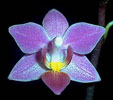|
|
|
|
|
| |
Flasks of
Phalaenopsis equestris 'Rebecca' AM/AOS × 'Hot Lips Houlihan' |
|
| |
|
|
| |
| Number: |
TN2932 |
| Name: |
Phalaenopsis equestris 'Rebecca' AM/AOS × 'Hot Lips Houlihan'
|
| |
Very LOW yield.
|
| Type: |
outcross (What's that?) |
|
Seed Donor: |
CJ Maciejeski
|
|
Click to Enlarge

Pod Parent Flower |
Click to Enlarge

Pollen Parent Flower |
Click to Enlarge

Offspring 'MC3731' Flowers |
| Offspring photos are siblings of the plants you would receive. |
|
|
|
| |
Culture Notes from Donor: Parent plants: Temperature range W (70-90°F)
Comments: Pod parent plant: Small plant. A particularly well-formed cultivar, this plant is highly awarded by the American Orchid Society. All segments glowing magenta-pink, dorsal sepal sparkling, lighter towards base and edges; petals somewhat wider than dorsal sepal, lightly ruffled, same color as other segments; lateral sepals spotted on lower half of basal area; labellum slightly darker than other segments, sidelobes deep reddish-magenta, callus shield-shaped, intense golden yellow, lightly speckled cinnamon. Substance firm for species, texture crystalline, form exceptional. Natural spread of flower 2.8 cm horizontally, 3.5 cm vertically; dorsal sepal 1.0 cm wide, 1.7 cm long; lateral petals 1.1 cm wide, 1.4 cm long; lateral petals 0.9 cm wide, 1.6 cm long; labellum 0.9 cm wide, 1.5 cm long.
Pollen parent plant: All segments, except the labellum, glistening white, flushed deep pink; dorsal sepal lightly striated with dark rose, flushed deep pink centrally and basally, fading to white along edges and apically, white, flushed pale pink on reverse with central dark rose stripe along midrib; lateral petals base color creamy white, flushed basally with deep pink, fading to white along edges and apically, lightly, flushed pink on reverse; lateral sepals wider than dorsal, flushed deep pink basally on dorsal half, striated with rose on ventral half with rose stripe along midrib, creamy white with rose midrib on reverse, midrib crease evident on both sides; sidelobes of labellum white basally, flushed rosy violet apically with internal striation of deep rose-violet dark violet spot corresponding with internal striation on reverse, callus ochre with rust speckles, midlobe very flat, deep rosy red and velvety, striated deep burgundy basally with extreme distal tip white, reverse rose with midrib evident; column deep pink dorsally, fading to white apically, white on ventral side, anther cap translucent white; overall form exceptionally full and flat for the species with full, wide petals and sepals; substance heavy, labellum hard; texture overall crystalline, labellum midlobe velvet, waxy elsewhere, column matte; natural spread 3.0 cm horizontally, 3.4 cm vertically; dorsal sepal 1.7 cm long, 0.9 cm wide; lateral petals 1.4 cm long, 1.0 cm wide; lateral sepals 1.4 cm long, 1.0 cm wide; labellum 1.4 cm long, 1.0 cm wide.
For additional origin/habitat information supplied courtesy of
Charles and Margaret Baker, see further below, near the bottom of this page.
|
Temperatures we attempt to use in the lab & greenhouse:
| For Species: |
|
Spring, Summer, Autumn, Winter: days average 88°F, nights 72°F; best fit is Warm 90-70°F
(Source:
Baker's Web OSC) |
| For Genus: |
|
Spring, Summer, Autumn, Winter: days average 87°F, nights 64°F; best fit is Warm-Intermediate 87-64°F
(
) |
|
About the name...
| Etymology of |
equestris |
|
From Latin "equestris" riding, one leaf upon the other.
(Source:
Mayr & Schmucker 1998) |
| Etymology of |
equestris |
|
From Latin "equestris" riding. In the case of genus Phalaenopsis, this refers to the saddle-shaped labellum.
(Source:
Troy Meyers) |
| Etymology of |
Phalaenopsis |
|
From Greek, "phalaina" moth; "-opsis" appearance.
(Source:
Pridgeon 1992) |
| Pronunciation of |
equestris |
|
ee-KWES-tris
(Source:
Hawkes 1978) |
| Pronunciation of |
Phalaenopsis |
|
fail-eh-NOP-sis
(Source:
Pridgeon 1992) |
| Pronunciation of |
Phalaenopsis |
|
fal-eye-NOP-sis
(Source:
Hawkes 1978) |
|
If you would like to direct someone to this web page, please copy and paste this URL into your email:
http://troymeyers.com/d?012932
| Flask Information |
| Availability: |
We have sold all of the flasks for this item. |
| You should: |
Consider getting individual plants or compots instead of a flask.
You can place a "Notify Flask Recipients" Request, and either we or a flask recipient may contact you when plants are available.
You may also place a "Notify Retries" Request, and if an identical pollination (the same parents) is done again, we'll let you know.
You may reserve a flask, but it's very unlikely you'll get one ...this could only happen if we found a flask that we didn't know we had. |
| Yield Estimate: |
37 plants (based on flask surveys done 11/25/2002 )
|
| Plantlet Sizes: |
From many flasks 30 mm plants (based on flask surveys done 02/11/2003 )
From one most recently surveyed flask 30 mm (02/11/2003)
|
|
You might also want to:
|
View the seed assay for this item.
View items of the same species.
View items of the same genus.
|
| Ordering Information |
| You are not currently logged in. |
|
You must be a registered user and be logged in to reserve a flask or place a notification request. Please log in:
|
|
|
|
|
|
| |
The origin/habitat information below is supplied courtesy of Charles and Margaret Baker
The following information is based on the name of the plant provided by the donor, and assumes that the name is correct. If the plant has been misidentified, then the following information may not be correct.
This text is copyrighted by the Bakers and may not be reproduced without permission.
ORIGIN/HABITAT: Luzon Island, Philippines, to Taiwan at 0-990 ft. (0-300
m), near streams in hot valleys.
More about this information and the Bakers...
|
|
|
| |
|
|
|